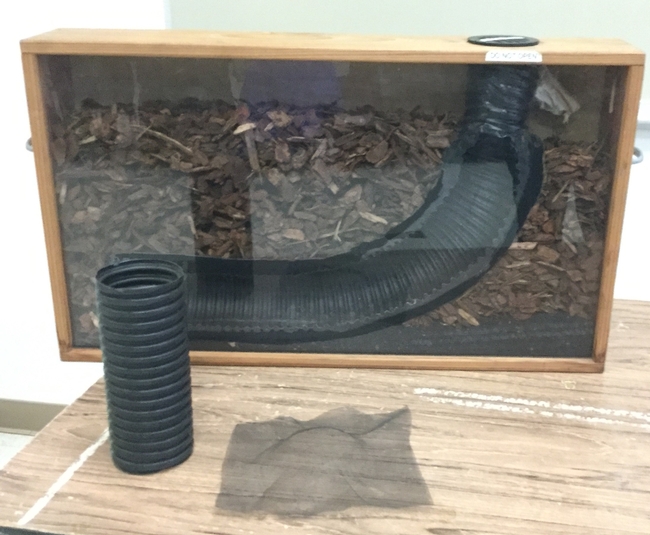Posts Tagged: invasive
Summer—it’s a time for swimming, BBQs, camping, and eating invasive species.
Last week during California Invasive Species Action Week (June 2 – June 10), we highlighted several pests, but there are many more invasive species out there. Now that you know about them, share your knowledge of invasive species with others. And no matter what your summer plans, here are some things YOU can do about invasive species from the California Department of Fish and Wildlife and California Department of Food and Agriculture.
YOU: I'M TRAVELLING TO AMAZING PLACES
- Learn what plants and animals you can bring into California.
- Don't pack a pest! Declare all food and agricultural items from other states or countries.
- Find out which species are threats to California.
- Learn about California's invasive plants.
- Avoid spreading forest pests: buy your firewood where you burn it.
YOU: I'LL BE WORKING IN MY GARDEN
- Remove invasive plants from your property.
- Select native or non-invasive plants for your garden.
- Use only certified weed-free forage, hay, seed, mulch, soil, and gravel.
- Learn alternatives to releasing unwanted fish, aquatic plants, and other pets.
- Monitor plants and trees for symptoms of infestations and disease.
- Learn about California's invasive plants.
- Have you spotted an invasive species? Tell us where by reporting your sighting.
YOU: I'LL BE NEAR THE WATER OR ON A BOAT
- Join the statewide citizen science effort to monitor for quagga mussels.
- Join the iNaturalist project, California Nerodia Watch, and help us find Nerodia watersnakes.
- Make sure to Clean, Drain, and Dry (PDF) your boat after each outing.
- Learn alternatives to releasing unwanted fish, aquatic plants, and other pets.
- Visit your favorite local, state, or national park, ecological reserve, recreational area, or nature center and ask about their volunteer programs.
- Learn about California's invasive plants.
- Have you spotted an invasive species? Tell us where by reporting your sighting.
YOU: I'LL BE OUT AND ABOUT CAMPING, HIKING, OR RIDING HORSES
- Use only certified weed-free forage, hay, seed, mulch, soil, and gravel.
- Avoid spreading forest pests: buy your firewood where you burn it.
- Prevent the spread of plant pathogens that damage and kill California's native plants and trees.
- Learn about California's invasive plants.
- Visit your favorite local, state, or national park, ecological reserve, recreational area, or nature center and ask about their volunteer programs.
- Have you spotted an invasive species? Tell us where by reporting your sighting.
YOU: I'LL DEFINITELY CONTINUE TO LEARN ABOUT INVASIVES
- Get to know your local invaders.
- Learn about California's invasive plants.
- Find out which species are threats to California.
- Learn alternatives to releasing unwanted fish, aquatic plants, and other pets.
- Eat them. Yum. Check out these websites to find out who is edible and how to prepare them.
- Invasive-eats.com (California-specific)
- Invasivore.org (under construction but hopefully back soon)
- EatTheWeeds.com
- EatTheInvaders.org
If you missed it this year, help in the fight next year by learning and participating during California Invasive Species Action Week.
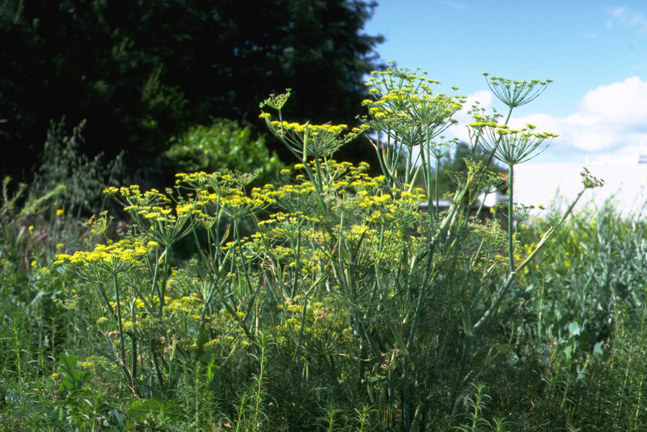
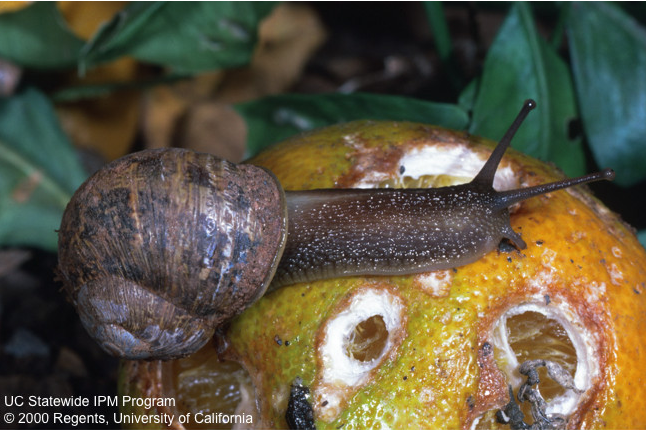
Invasive species...not very a-peel-ing for citrus.
Citrus plants can be hosts for invasive pests. Knowing what pests are invasive and how to avoid them is an important part of nursery production. If you work in a citrus nursery, you play an important role in looking for invasive pests and protecting the nursery—and ultimately California's citrus industry—from invasion.
Your mission, should you choose to accept it, is to prevent invasive pests and their harmful impact to agriculture. When pests or diseases are new to an area, we call them invasive. Many of the laws that are in place for citrus are to prevent new pests and diseases from establishing.
Citrus nurseries that become infested with new pests may be quarantined until the infestation is gone, preventing the plants from being moved or sold. Sometimes it requires the plants to be destroyed. Sometimes it results in the loss of a business.
You might have heard of some these invasive pests in California citrus—diaprepes root weevil, light brown apple moth, and red imported fire ant. Some invasive pests are diseases carried by an insect such as citrus variegated chlorosis spread by glassy winged sharpshooter, brown citrus aphid in Florida and Mexico making citrus tristeza even more problematic, and huanglongbing spread by Asian citrus psyllid.
Learn more about these invasive pests and how to stop their invasion by viewing an online training for workers of citrus growing in protective structures by UC Cooperative Extension Specialist Beth Grafton-Cardwell. Citrus Nursery Protective Structure Worker Training provides information on growing healthy citrus plants in structures and protecting them from common insect pests and diseases, including invasive ones in Chapter 3. You can also find on UC IPM's online training webpage, training about Asian citrus psyllid and huanglongbing for retail nursery personnel and for UC Master Gardeners.
When pests first arrive in California, an effort is made to detect them by searching the plants and by trapping them. It is important for you to be a detective and help in this effort:
- Watch for anything unusual and report anything new.
- Keep yourself and anything you work with in the protected structure clean, disinfected and free of pests.
- Keep the protective structure sound by fixing holes in screens, gaps in the structure, and unprotected vents.
- Use good practices in the nursery such as planning your day to start indoors and finish outdoors so that you don't bring outdoor pests inside.
- Don't bring in pests from other areas in budwood or fruit.
Californians can help in the fight against invasive species by learning and participating during California Invasive Species Action Week, June 2–10.
During the week, spend your lunch with us learning the latest about invasive tree killing pests, aquatic nasties like quagga mussels and nutria, and how the invasive weed/wildfire cycle is altering our ecosystems!
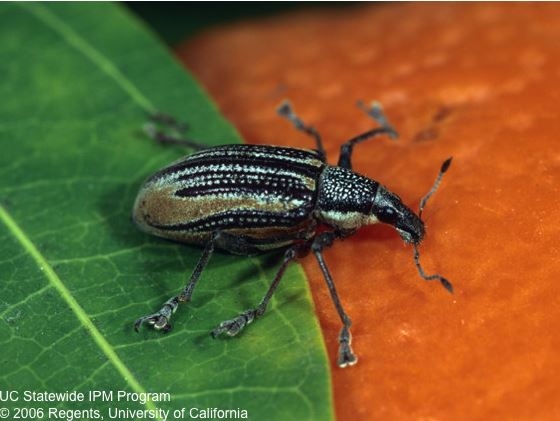
National invasive species awareness week was February 27 – March 3, 2017.
Invasive species are plants, animals, fungi or microbes that are not native to an area, but can quickly establish, multiply, and become pests. These species can hurt the environment, agricultural production, and even human health in some instances (e.g. the mosquito Aedes aegypti). According to the USDA, invasive species are responsible for $137 billion per year in economic losses in the United States.
In agricultural systems, invasive species may reduce yields, render crops unmarketable, or make rangeland unfavorable to livestock. In natural areas, they may squeeze out native species, change soil quality, and increase the frequency or intensity of wildfires.
Some of these species have been introduced intentionally (e.g., yellow sweetclover, which was originally imported from Europe as a forage species for livestock), while others arrived by accident (e.g., the glassy-winged sharpshooter which came to California inadvertently through nursery stock shipments).
Just one species can be detrimental to crop production and revenues. The invasion of spotted-wing drosophila, for example, caused conventional raspberry growers in California to lose $36.4 million in revenue between 2009 and 2014, and would have reduced California raspberry yields by as much as 50% without control efforts.
The spread of invasive pests has become more prevalent in recent decades, and is linked to several factors, including global travel, produce trade, and climate change. Many invasive pests spread by human movement—medusahead, for example, has long awns on its seeds that easily attach to clothing and animal fur, to be carried to other locations. A recent study by UC scientists also determined that due to climate change, invasive weeds are shifting their ranges at a faster rate than native plants, and will likely cause more problems in agriculture and natural resources in the future. The yellow starthistle, an invasive plant that dries out soil and degrades rangelands, is one of the pests that will expand its range further north in California (and beyond) due to climate change.
While invasive pests can be a major challenge to growers and land managers, there are successful stories of stopping exotic pest invasions with well-coordinated eradication efforts. Recently, the California Department of Food and Agriculture (CDFA) declared the European Grapevine Moth eradicated from California after no moths were found in the state from 2015 to 2016. This was due to a rapid response, largely by the UC Cooperative Extension scientists after the moth was discovered in Napa vineyards in 2008.
Here's what you can do to keep from introducing or spreading invasive species:
- Fully cooperate with agricultural inspections at the California state border and in your fields. When coming into California from another state, declare any plant or animal material that you have in your vehicle. Inspectors will thoroughly examine your materials or crops to make sure that they do not hold any invasive pests. This greatly reduces the chance that your activities will spread harmful invasive species.
- Check and clean your clothes, shoes, and equipment before you move from one location to another. For example, thoroughly cleaning your shoes with water and a disinfectant after hiking through an area known to have sudden oak death will prevent you from tracking the pathogen into uncontaminated areas. Similarly, checking your clothes or shoes for weed seeds before leaving an area will keep you from spreading invasive weeds.
- “Burn it where you buy it.” Burn firewood in the same place you purchased it, rather than buying it and transporting it elsewhere. If you must transport firewood, be sure to declare it at the border and have it inspected, as described above.
- Report invasive pests in your area. CDFA has a tool for reporting pests, but you can also contact your agricultural commissioner or UC Cooperative Extension to do so.
To learn more about invasive species, visit the UC IPM website. You will find a list of invasive insects, plants, diseases, and vertebrates in California, as well as links to other organizations and regulatory agencies that are also working to reduce their numbers.
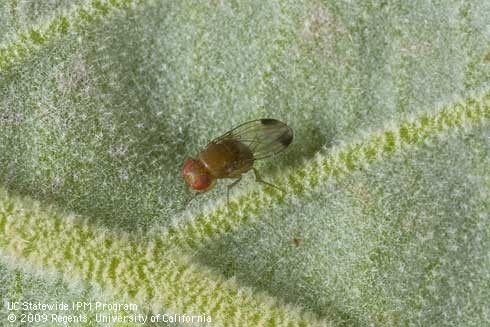
The South San Joaquin Valley Region Invasive Aedes Workshop was held at Kearney Jan 20, 2017.
First reported in California in June 2013, the invasive mosquito Aedes aegypti can vector four viruses: yellow fever, dengue, Khikungunya and Zika. Moderated by entomologist Anthony Cornel, Ph.D. at Kearney Agricultural Research & Extension Center and the entomology department at UC Davis, the workshop's agenda included
- Programmatic updates and discussion on surveillance, control, public outreach activities, and research efforts in greater Los Angeles County Vector Control District and the Consolidated Mosquito Abatement District of the South San Joaquin Valley Region
- Evaluation and discussion of surveillance techniques and integrated vector management approaches to control invasive Aedes in areas where established and newly invaded
- Public outreach and community involvement
- Response plans: discussion of how plans address the invasion/expansion of invasive Aedes, the mosquito control efforts in response to imported disease cases, and the response to autochthonous transmission of the disease
- Discussion and summary
Many informational posters from the California Department of Health were available. There was also a sample of a screened storm water drain to exclude Aedes from underground egg laying locations.
KARE and USDA collaborators visit Israel to learn more about the Polyphagous Shot Hole Borer.
In 2003, the Polyphagous Shot Hole Borer (PSHB) was observed in Southern California. This beetle has a Fusarium sp. symbiont that causes susceptible host tree damage. The PSHB appears to be established in Los Angeles, Orange, and Riverside Counties. In the Los Angeles area, PSHB has attacked over 200 species of native, ornamental and horticultural trees, including the native Coast Live Oak, California sycamore, and about 57% of the commonly used street trees in the area. Avocado trees are susceptible; the beetle and fungus have been found in several backyard avocado trees as well as some commercial avocado orchards in Los Angeles and Orange counties. The PSHB has caused severe damage to commercial avocado orchards in Israel, and is a threat to California’s avocado crop which is worth about $460.6 million and accounts for about 87% of the US production.
To better understand the biology of and potential management strategies for the PSHB Fusarium complex threatening California’s avocado trees, Mary Lu Arpaia, Subtropical Horticulture Extension Specialist in the UC Riverside Botany and Plant Sciences Department and Kearney Agricultural Research and Extension Center, and David Obenland, Plant Physiologist, at USDA-ARS in Parlier, California, visited Israel in March, 2013. The PSHB is an invasive pest in Israel and was found in Israel’s commercial avocado orchards in 2009. The PSHB in Israel is causing serious damage, and Israeli research may help us develop detection and management strategies in California.
Biology and Behavior: A visit with Drs. Zvi Mendel and Stanley Freeman, Israel’s lead PSHB researchers provided insight into research on the biology and behavior of the PSHB Fusarium complex. Drs. Mendel and Freeman contend that even though the beetle uses several tree species as hosts, it is monophagous, only feeding on the Fusarium symbiont. According to their research, the beetle’s reproductive cycle in susceptible trees is: the adult pregnant female beetle bores through a tree’s bark, creates galleries under the bark, infests the galleries with a Fusarium fungal symbiont carried in the adult beetle’s mycangium (a specialized structure at the back of the jaw), and lays eggs in the galleries. Larvae are mostly female. While the larvae develop, the Fusarium sporulates. The developing larvae eat the fungus, develop into adults in about a month, and mate while in the gallery. The pregnant females exit the gallery through exit holes in the bark. To survive, the emerged pregnant female has about 48 hours to find a suitable host location and continue the life cycle.
Hygiene: The geographic area where the beetle is found in Israel appears to be expanding, even though the infested avocado trees in the primary infested area were destroyed. The PSHB is thought to have been transported in bins originating from the infested area. A best practice for California growers and packers will be to use clean bins and ensure that there is no vegetative matter in the bins prior to transport. This practice will also help reduce the spread of avocado thrips and persea mite.
Chemical control of the beetle or the fungus: There has been limited success in controlled lab situations, but field applications are not effective. So far, no effective chemical control technologies have been developed for the beetle.
Infestation: A mature orchard that was infested approximately 5 to 6 years ago became heavily infested within 2 to 3 years, and will be bulldozed. Infestations may require bulldozing orchards.
Detection: Mature avocado orchards with heavy infestation have severe limb dieback, many broken branches littering the orchard floor, dropped mature fruit, abnormally small mature fruit, and sugar exudates caused by the bore holes. A 2-year-old infested orchard did not exhibit very much limb dieback; when infestation of young trees is observed, it is usually on the base of the trunk (found in either the rootstock or the scion wood).
Spread to native and landscape hosts: Israel has seen the spread of the beetle to native oaks and the box elder. California will need to educate the public to help safeguard our native and landscape trees from the spread of the PSHB and Fusarium complex. Native and landscape tree infestations may make it difficult to control the spread of infestations into commercial avocado orchards.
California outlook: California must be diligent in looking for tree infestation. The avocado industry is working with the landscape industry and forestry service in California to understand the rate of infestation and range of susceptible hosts. Funding for surveys; understanding the beetle and fungal biology; developing control strategies, technologies and practices; and basic work on the origin of the beetle is essential. California researchers should collaborate with and learn from their Israeli colleagues.

Avocado tree in Israel with limb breakage and branch dieback due to PSHB infestation and its Fusarium symbiont (photo by M. L. Arpaia).

External symptoms of PSHB infestation, including sugar exudate, bark darkening, and wood staining due to Fusarium infection of the woody tissue (photo by M. L. Arpaia).
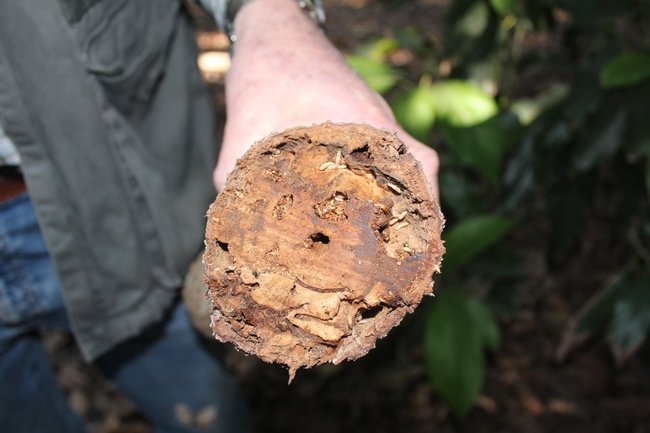
PHSB infested avocado branch in later stages of decline. The white larvae are termites that infested the branch after dieback started. Note the staining of the wood and evidence of the PHSB galleries. (photo by M.L. Arpaia)
